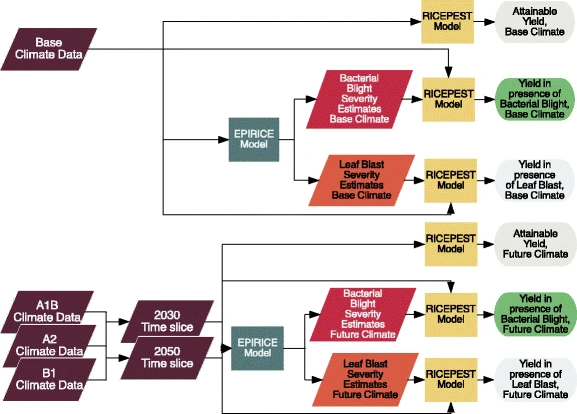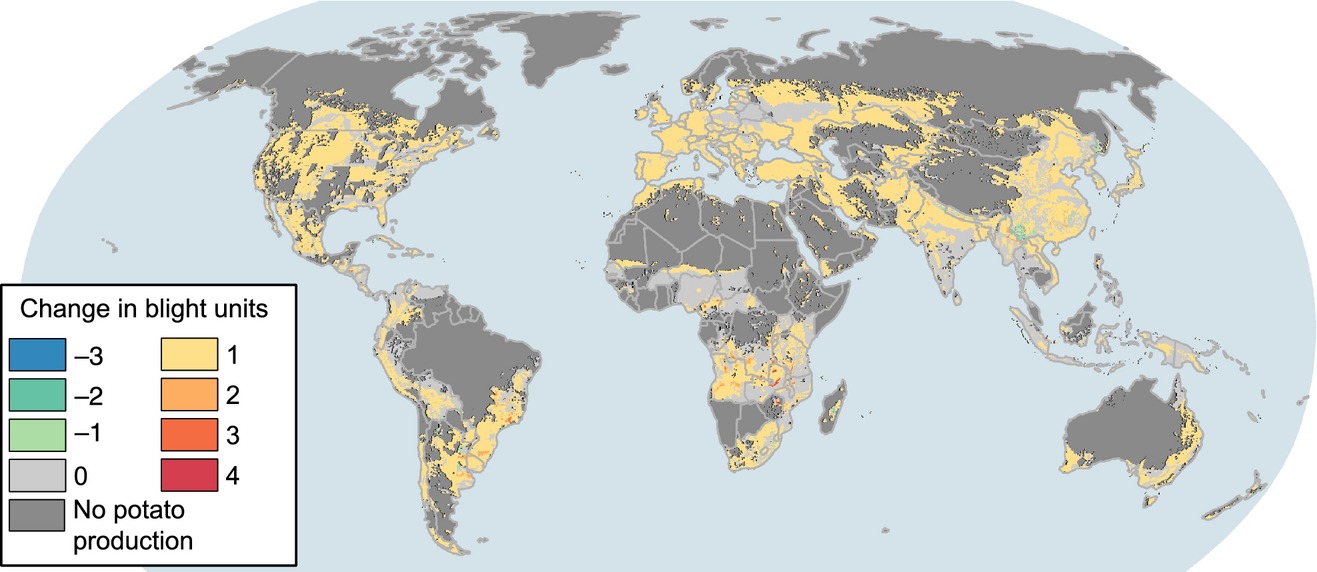Andrade-Piedra, J. L., Forbes, G. A., Shtienberg, D., Grünwald, N. J., Chacón, M. G., Taipe, M. V., et al. 2005a. Qualification of a plant disease simulation model: Performance of the LATEBLIGHT model across a broad range of environments. Phytopathology. 95:1412–1422.
Andrade-Piedra, J. L., Hijmans, R. J., Forbes, G. A., Fry, W. E., and Nelson, R. J. 2005b. Simulation of potato late blight in the Andes. I: Modification and parameterization of the LATEBLIGHT model. Phytopathology. 95:1191–1199.
Andrade-Piedra, J. L., Hijmans, R. J., Juárez, H. S., Forbes, G. A., Shtienberg, D., and Fry, W. E. 2005c. Simulation of potato late blight in the Andes. II: Validation of the LATEBLIGHT model. Phytopathology. 95:1200–1208.
Bruhn, J. A., Bruck R., I., Fry W., E., Arneson P., A., and Keokosky, E. V. 1980. User’s manual for LATEBLIGHT: A plant disease management game. Ithaca, NY, USA: Cornell University, Department of Plant Pathology.
Doster, M. A., Milgroom, M. G., Fry, W. E., et al. 1990. Quantification of factors influencing potato late blight suppression and selection for metalaxyl resistance in Phytophthora infestans: A simulation approach. Phytopathology. 80:1190–1198.
ECMWF. 2023.
Cdsapi. ECMWF. Available at:
https://github.com/ecmwf/cdsapi/tree/master.
Falagas, A. 2023.
Pynasapower. Available at:
https://github.com/alekfal/pynasapower.
Fick, S. E., and Hijmans, R. J. 2017.
WorldClim 2: New 1‐km spatial resolution climate surfaces for global land areas. International Journal of Climatology. 37:4302–4315.
Fry, W. E., Apple, A. E., and Bruhn, J. A. 1983. Evaluation of potato late blight forecasts modified to incorporate host resistance and fungicide weathering. Phytopathology. 73:1054–1059.
Grünwald, N. J., Montes, G. R., Saldaña, H. L., Covarrubias, O. A. R., and Fry, W. E. 2002. Potato late blight management in the Toluca Valley: Field validation of SimCast modified for cultivars with high field resistance. Plant Disease. 86:1163–1168.
Hijmans, R. J. 2017. Rlateblight: Potato late blight models.
Hijmans, R. J., Barbosa, M., Ghosh, A., and Mandel, A. 2023.
geodata: Download geographic data. Available at:
https://CRAN.R-project.org/package=geodata.
Hijmans, R. J., Savary, S., Pangga, R., and Aunario, J. 2009. cropsim: Simulation modeling of crops and their diseases.
Hufkens, K., Stauffer, R., and Campitelli, E. 2019. The
ecwmfr package: An interface to
ECMWF API endpoints. Available at:
https://bluegreen-labs.github.io/ecmwfr/.
Hyre, R. A. 1954. Progress in forecasting late blight of potato and tomato.
Karger, D. N., Conrad, O., Böhner, J., Kawohl, T., Kreft, H., Soria-Auza, R. W., et al. 2017.
Climatologies at high resolution for the earth’s land surface areas. Scientific Data. 4.
Karger, D. N., Schmatz, D. R., Dettling, G., and Zimmermann, N. E. 2020.
High-resolution monthly precipitation and temperature time series from 2006 to 2100. Scientific Data. 7.
MacKenzie, D. R. 1981. Scheduling fungicide applications for potato late blight with Blitecast.
Mendiburu, F. de. 2023.
agricolae: Statistical procedures for agricultural research. Available at:
https://CRAN.R-project.org/package=agricolae.
Narouei-Khandan, H. A., Shakya, S. K., Garrett, K. A., Goss, E. M., Dufault, N. S., Andrade-Piedra, J. L., et al. 2020.
BLIGHTSIM: A new potato late blight model simulating the response of Phytophthora infestans to diurnal temperature and humidity fluctuations in relation to climate change. Pathogens. 9:659.
Savary, S., Esker, P., McRoberts, N., Willocquet, L., Caffi, T., Rossi, V., et al. 2015. Models for crop diseases: Overview of approaches & scales.
Savary, S., Nelson, A., Willocquet, L., Pangga, I., and Aunario, J. 2012.
Modeling and mapping potential epidemics of rice diseases globally. Crop Protection. 34:6–17.
Schouten, R., and Poisot, T. 2023.
RasterDataSources.jl. Available at:
https://github.com/EcoJulia/RasterDataSources.jl.
Sommer, P. S. 2022.
Latlon_utils. Available at:
https://github.com/Chilipp/latlon-utils.
Sparks, A. H. 2022.
Simulation modelling of crop diseases using a Healthy-Latent-Infectious-Postinfectious (HLIP) model in Julia. Available at:
https://github.com/adamhsparks/Epicrop.jl.
Sparks, A. H., Forbes, G. A., Hijmans, R. J., and Garrett, K. A. 2014.
Climate change may have limited effect on global risk of potato late blight. Global Change Biology. 20:3621–3631.
Sparks, A. H., Hijmans, R., Savary, S., Pangga, I., and Aunario, J. 2023a.
epicrop: Simulation modelling of crop diseases using a susceptible-exposed-infectious-removed (SEIR) model. Available at:
https://codeberg.org/adamhsparks/epicrop.
Sparks, A. H., Ponte, E. M. D., Alves, K. S., Foster, Z. S. L., and Grünwald, N. J. 2023b.
Openness and computational reproducibility in plant pathology: Where we stand and a way forward. Phytopathology®. 113:1159–1170.
Tsakalos, J. L., Smith, M. R., Luebert, F., and Mucina, L. 2023. climenv: Download, extract and visualise climatic and elevation data. Journal of Vegetation Science.
Wallin, J. R. 1962. Summary of recent progress in predicting late blight epidemics in United States and Canada. American Potato Journal. 39:306–312.
Yun Chan, M. 2023.
CDSAPI.jl. Available at:
https://github.com/JuliaClimate/CDSAPI.jl.
Zopf, R., Giabbiconi, C. M., Gruber, T., and Müller, M. M. 2004. Attentional modulation of the human somatosensory evoked potential in a trial-by-trial spatial cueing and sustained spatial attention task measured with high density 128 channels
EEG. Cognitive Brain Research. 20:491–509 Available at:
https://www.sciencedirect.com/science/article/pii/S0926641004001296 [Accessed March 6, 2024].






provides:
provides:
(a fork of {cropsim})



